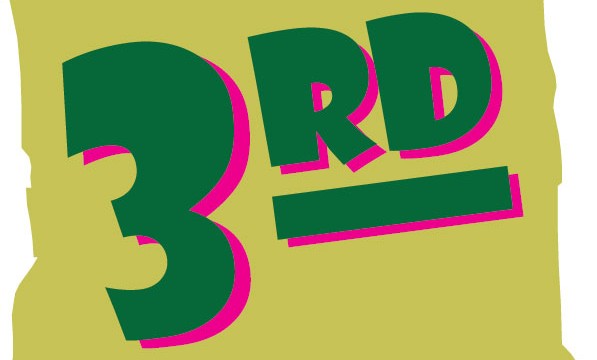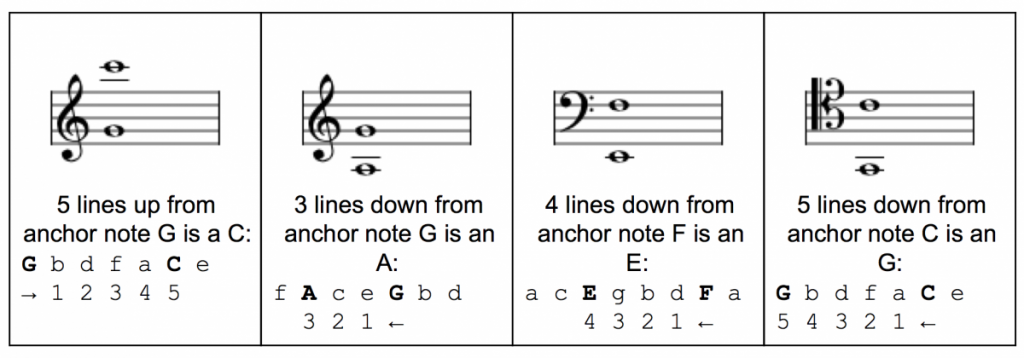
Along their musical education, most piano students learn the circle of fifths. They probably develop some fuzzy connection between the circle of fifths and keys: G Major has one sharp and its tonic is a perfect fifth above C; D Major has two sharps and its tonic is a perfect fifth above G; etc. Perhaps they will learn that the order of sharps is an ascending circle of fifths, and the order of flats is a descending circle of fifths. If they are very lucky, they will begin to understand the human ear’s affinity for the circle of fifths and its implications on tonal harmony (think ii V I).
But, for all the glory that the circle of fifths deserves, I believe that the circle of thirds should be taught to our music students long before the circle of fifths, because the circle of thirds is the foundation of reading music and building harmony.
Consider how many students are introduced to the treble staff. Most of us began to read by learning some crutch phrase, like “Every Good Boy Does Fine.” We then learned that the first (bottom) line of the treble clef staff was an E (Every), the next line up was a G (Good), and so forth. The problem with “Every Good Boy Does Fine” (what about girls? or bad boys?) is that it does nothing to teach the structure of a staff or an understanding of the staff. The student is left with nothing to help them read ledger lines or staves with different clefs. To read the bass clef, students must learn another crutch phrase (I learned “Good Boys Deserve Fudge Always” … how come I didn’t always get fudge?). And to learn ledgers? I don’t recall receiving much help for that. And forget C clefs. I had to navigate that one completely on my own.
With the circle of thirds memorized, deciphering a staff uses the same skill no matter what clef is used: Identify the anchor note (G for treble clef, F for bass clef, and C for C clef), and then count up or down the lines to find the note along the circle of thirds. It doesn’t matter if the lines are on the staff or if they are ledger lines. The counting is the same.
(I’ve always wondered how most European countries teach reading, since they use solfege instead of letter names. I wouldn’t be surprised if they used the circle of thirds.)
Knowing the circle of thirds also facilitates identifying and creating triads. Creating a triad from the circle of thirds is trivially simple. What’s the tonic? F. Walk up the circle of thirds, and name the triad F A C.
I want all of my students to be able to look at any three notes of a triad on a staff and easily identify the root of that triad. In the early stages of learning this skill, the circle of thirds can be very helpful.
Consider the D minor chord shown to the right. A student who is trying to decipher this chord might start by reading the notes from the top down. The top note is an F. With knowledge of the circle of thirds, the notes possible to fit within a triad that has an F are:
B D F A C
The next note down is an A. That removes the B as an option, leaving these as the possible notes in the chord:
D F A C
The next note down is a D. At this point, the student can identify the root of the triad:
D FA
When we teach in letter names, the circle of thirds going up is an easy mnemonic:
GBD FACE (pronounced Gee-Bee-Dee Face).
Students who repeat GBD FACE repeatedly (Gee-Bee-Dee Face Gee-Bee-Dee Face …) for a whole week can easily remember the ascending circle of thirds. Going in descending order takes a bit more thinking. Unfortunately, I know of no other way to learn to navigate fluently up and down the circle of thirds in solfege than to employ lots of verbal repetition. (Do Mi Sol Si Re Fa La Do Mi … and Do La Fa Re Si Sol Mi Do La …)
Becoming fluent in reading and in chord recognition takes practice. [Ideally these skills are developed on many levels: analytical understanding (do you understand how it is constructed?), visual understanding (do you see it on the keyboard?), and aural understanding (can you hear it?).] However, without knowing how to fully decipher the staff or triad, a student attempting to become fluent in these skills is easily frustrated. They do not understand the logic behind what they are attempting to memorize, and hence they cannot self correct during the process. In my next post, I will talk about how to use fingers to help students navigate the circle of thirds.



You have a mismatch in the second to last paragraph – “Students who repeat GDB FACE repeatedly (Gee-Bee-Dee Face Gee-Bee-Dee Face …) ” – I’m pretty sure you meant GBD FACE as that would be the circle of thirds..
Thanks! Even when I went in to fix it, I felt my fingers pulling to “gdb”, which is the name of a computer programming debugger that I used for years and years during my computer years.
What confuses me as a novice is where are the sharps and flats? Looking at the example should the third for D not be F# and where is the rest?
(Sorry for the delay in responding!)
The circle of thirds focusses just on the letter names, not the quality of the third. D♭ to F is a major third, D to F is a minor third, D to F♭ is a diminished third, and D♭ to F♯ is an augmented third. The qualities and number of half steps of each of these intervals are different, yet they are all considered thirds simply because they are spelled with two letter names that are a skip away from each other. These same intervals could be spelled with enharmonic equivalents that sound the same but are given different names for the interval (e.g. C♯ to F is a diminished fourth, not a major third, because C to F is a fourth).
I consider mastering the circle of thirds a “micro-skill” — something that is useful in creating fluency in another skill. As mentioned above, mastering the circle of thirds helps with reading, with building chords, and with identifying the factors of a chord.
I suspect one potential source of confusion that could lead to your original question comes from what we traditionally call the “Circle of Fifths”: C G D A E B F♯/G♭ C♯/D♭ A♭ E♭ B♭ F C … Note that this sequence has specific ♯’s and ♭’s included, unlike my “Circle of Thirds”.
I teach the above as the “Circle of Perfect Fifths”, since the motion described is a very specific kind of fifth. (Note that somewhere along the way, we must substitute with a diminished 6th in order to move from ♯’s to ♭’s — e.g., C♯ to A♭)
The generic “Circle of Fifths” that I teach does not include accidentals. The sequence is the same as the letter names we learn to recite for the order of sharps: F C G D A E B (F C G D A E B …) . This is the circle of fifths by letter names only – each successive letter represents a fifth away, without regard to the quality of the fifth.
One would want to learn the generic circle of fifths as a micro-skill for similar reasons as we learn the circle of thirds: to enable fluency in other skills. The generic circle of fifths helps us learn the order of sharps, identify fifth relationships in harmonic circle progressions (b° to FM is a fifth relationship in harmonic motion, even though the motion is not by perfect fifth), quickly identify the root of a triad written in open voicing (look for the lower of two notes that are a fifth apart), and master the naming of any perfect fifth. (All perfect fifths have the exact same accidental or lack thereof on each note – e.g., [ C♯ G♯ ], [D♭ A♭] [E B] – EXCEPT for B to F – i.e., [B♭ F] and [B F♯].)
I hope this answered your question and then some!
Great read. Thank you, Henry 🙂 P.S. Walking up GBDFACE, the G Bm Dm F Am C Em progression is actually pretty nice (just got completely distracted playing around with it) – might serve to reinforce the mnemonic, too.
Thank you! I could easily imagine that progression being suitable for a song.
Here is how I understand the circle (or rather spiral) of thirds: https://commons.wikimedia.org/wiki/File:Circle-of-fifths-OrgPad.png the original image can be printed to e.g. A1
If you want the interactive version you can access it (copy it and change it, if you want) in OrgPad here: https://www.orgpad.com/s/GqKqHVGEWbX
That’s a cool organization of the circle of perfect fifths. We don’t typically see a circle of major thirds or minor thirds, probably because they never will cover all 12 chromatic pitches. A circle of major thirds, e.g., C E G# B# …, quickly lands on the same enharmonic note it started. Being fluent in diatonic intervals or “generic” intervals – i.e., just the interval number but not the quality of the interval (perfect, major, minor) – is useful for reading, building triads, spelling intervals correctly, etc.
For the record, I am one of the developers behind OrgPad.com. I am also quite interested in music 🙂
Yes, well the idea was that in the interactive version, you can open some of the cells, which would be an enharmonic “crossover” so to say and look up, which other notations apply in that case. Just try it out in a modern web browser, such as Chrome – we are working on supporting Safari as well, but it doesn’t work well as of 9th of December 2021.
OrgPad is quite popular in education, it is like interactive Post-Its, that you can easily share for viewing or editing, that don’t fall off and where you can e.g. add a picture, video or music or embedd a webpage. Everything is private by default, but you can publish an OrgPage so everybody on the internet sees it.
The cycle of 3rds is a complication… Just learn how chords are formed
Learning circles of every interval is one tool to help master reading by interval, such as when you’re transposing on the fly or reading an unfamiliar clef.